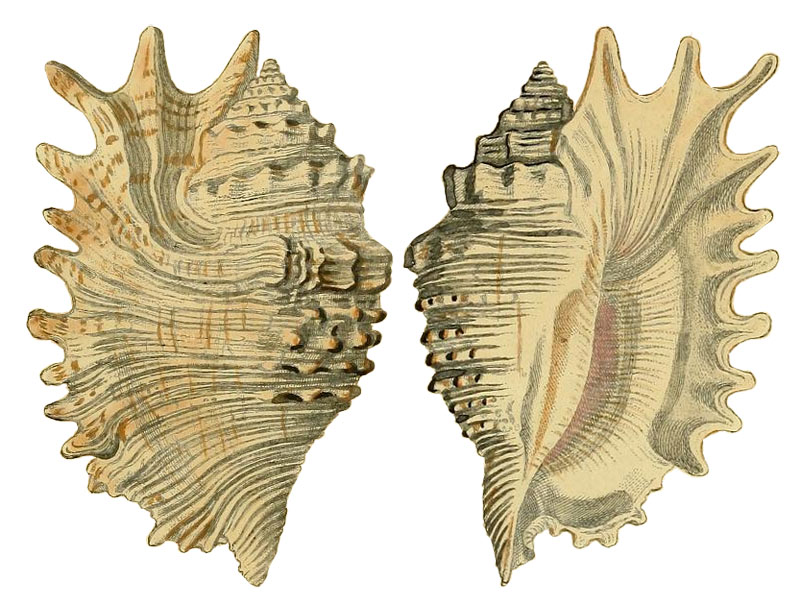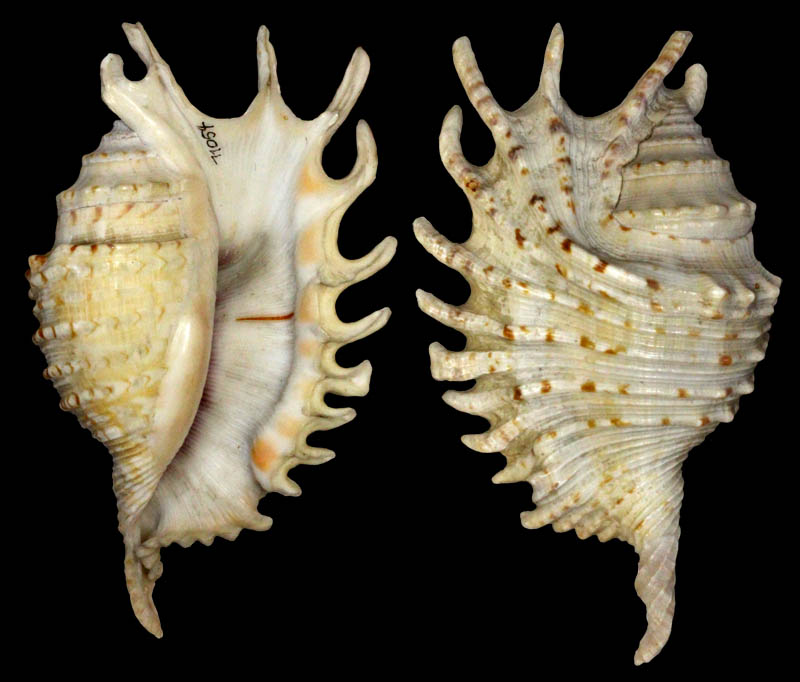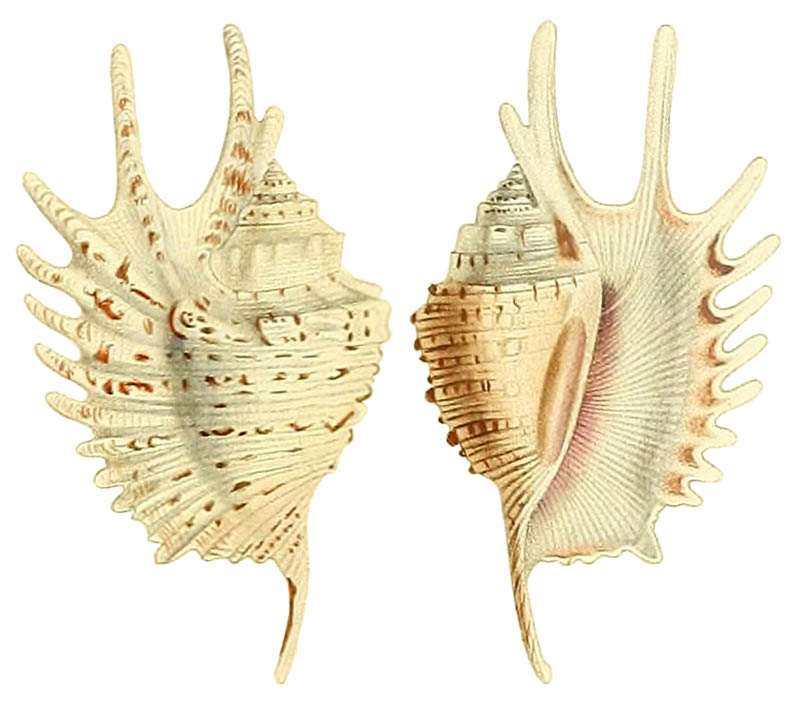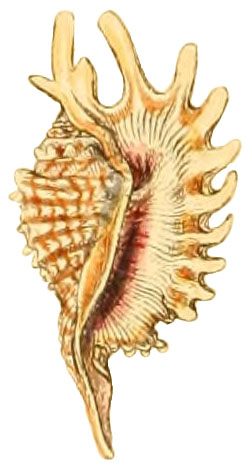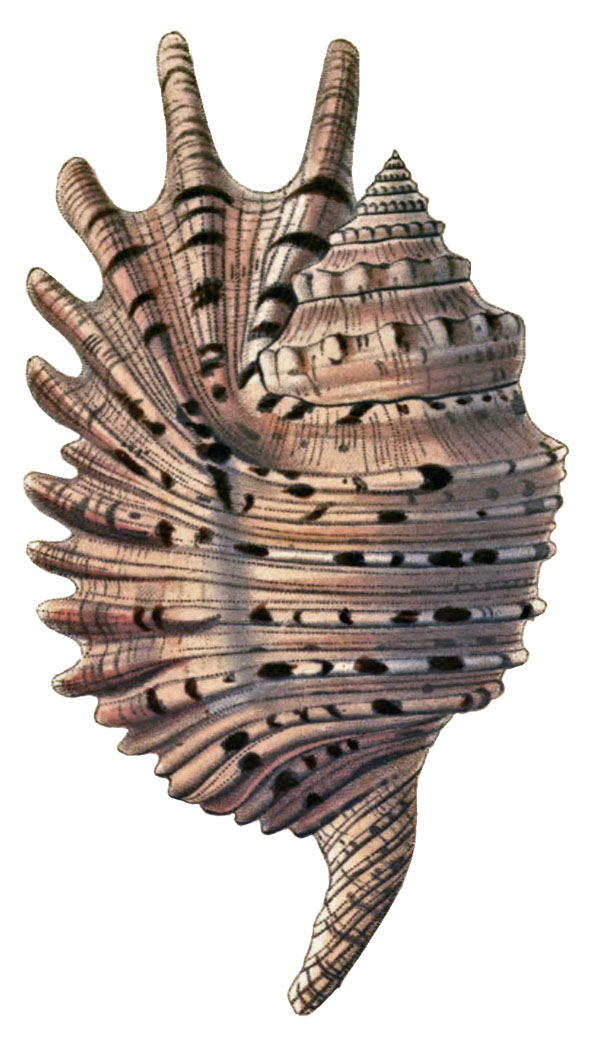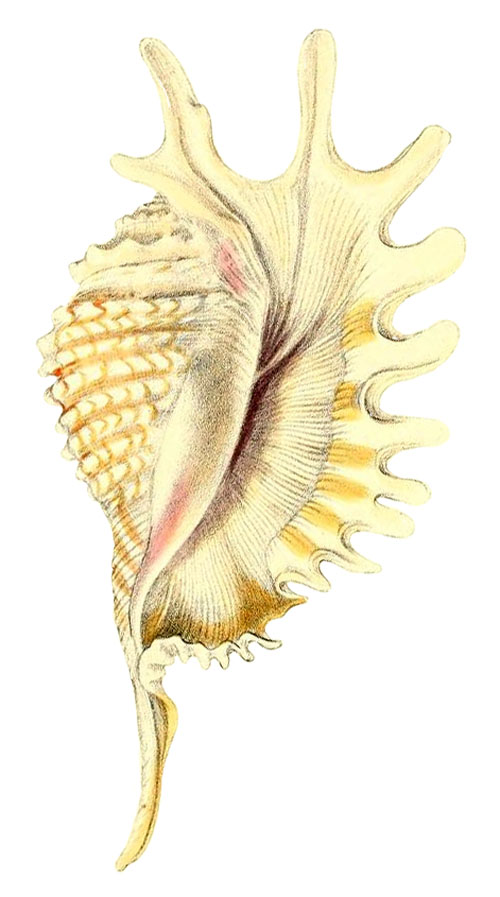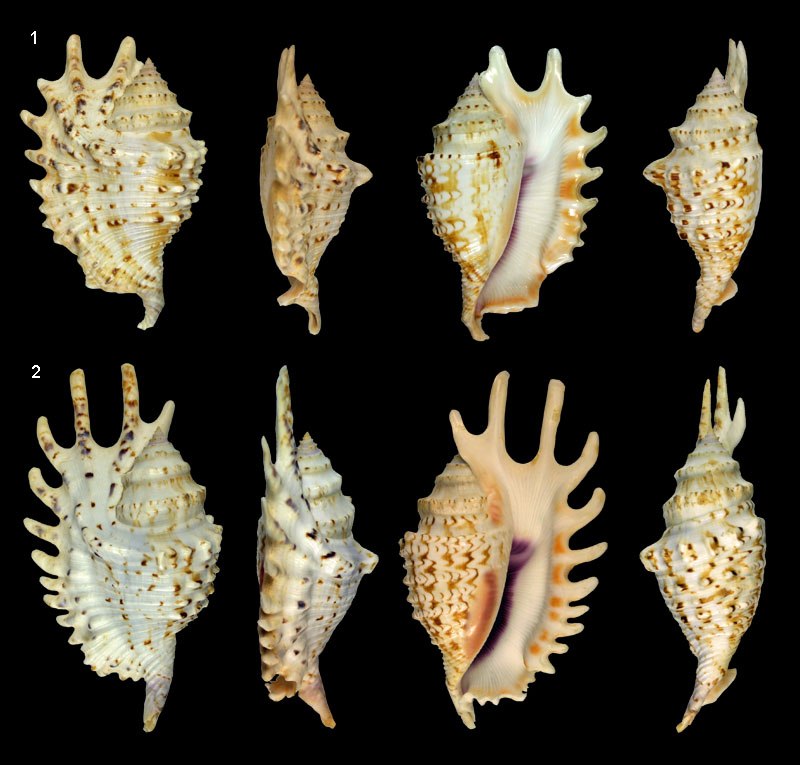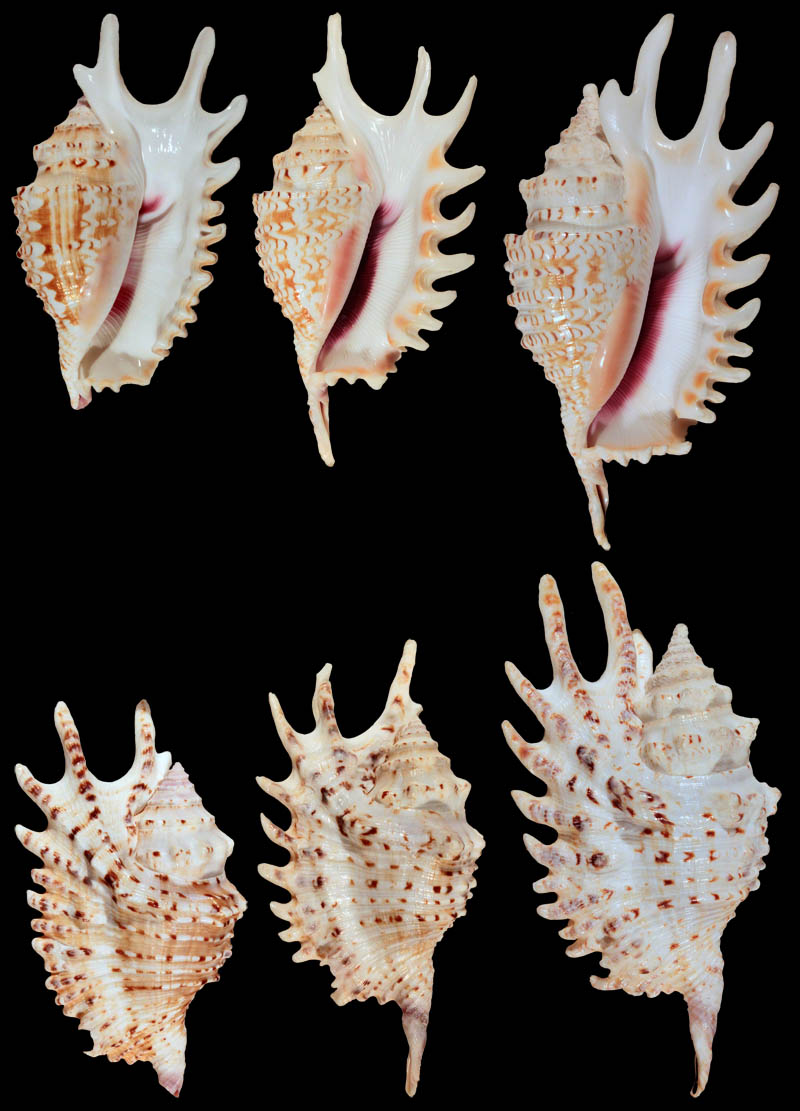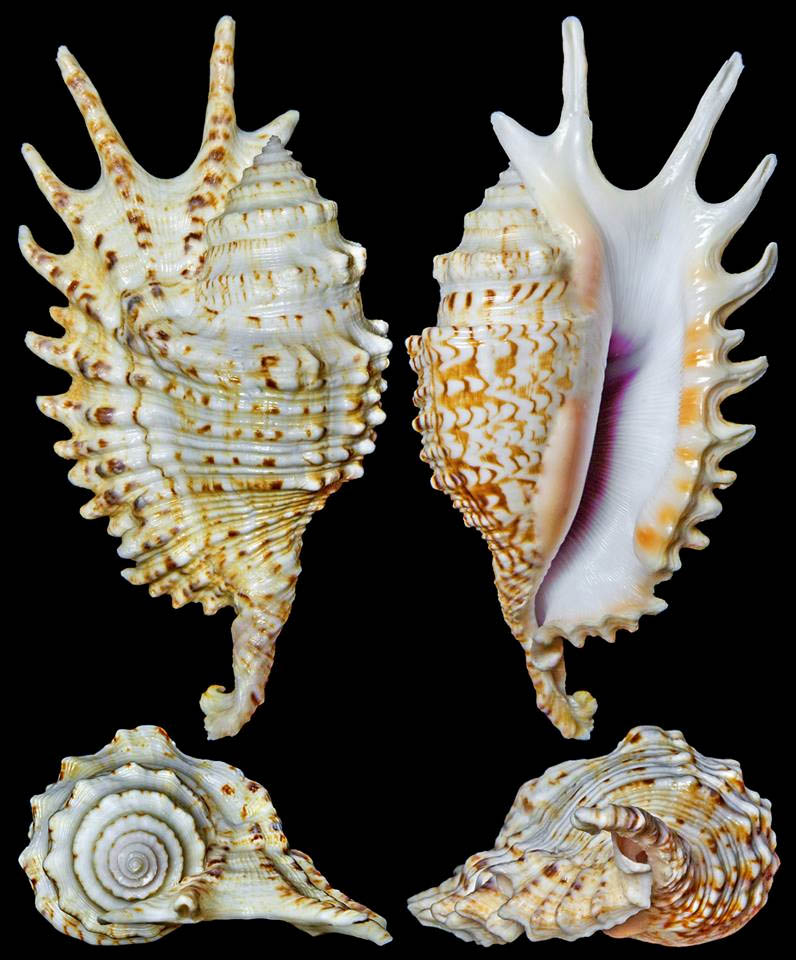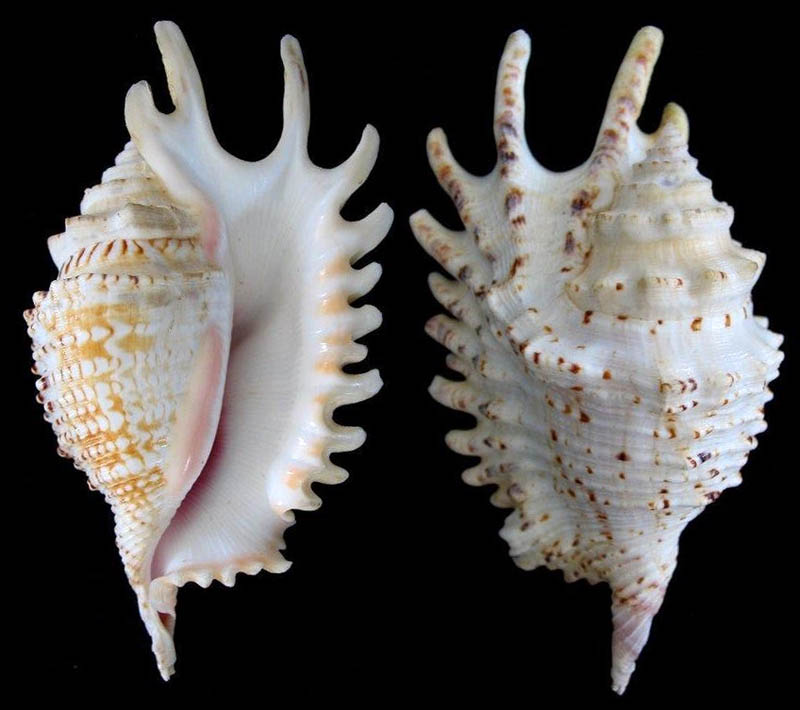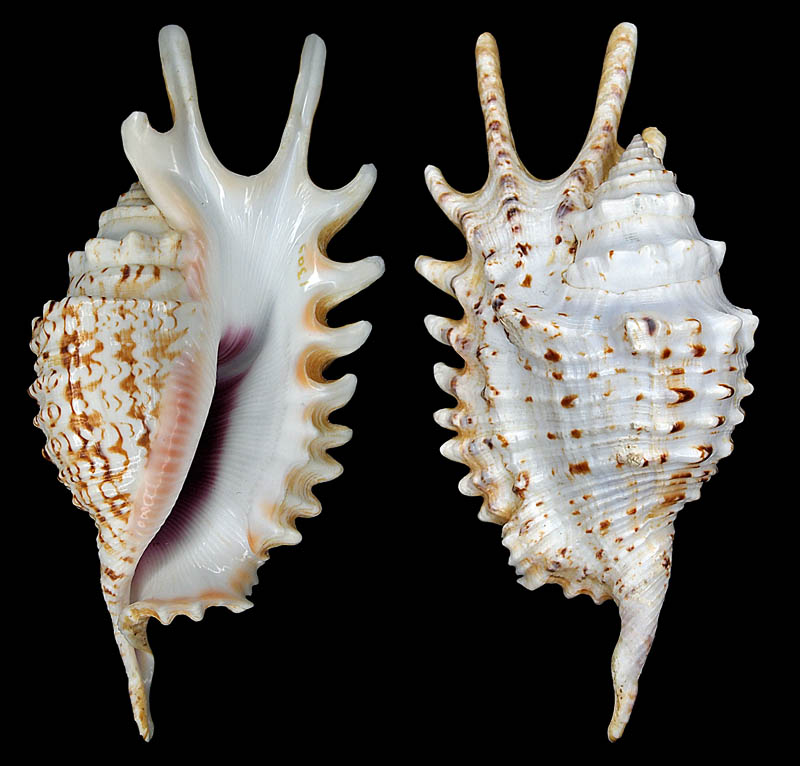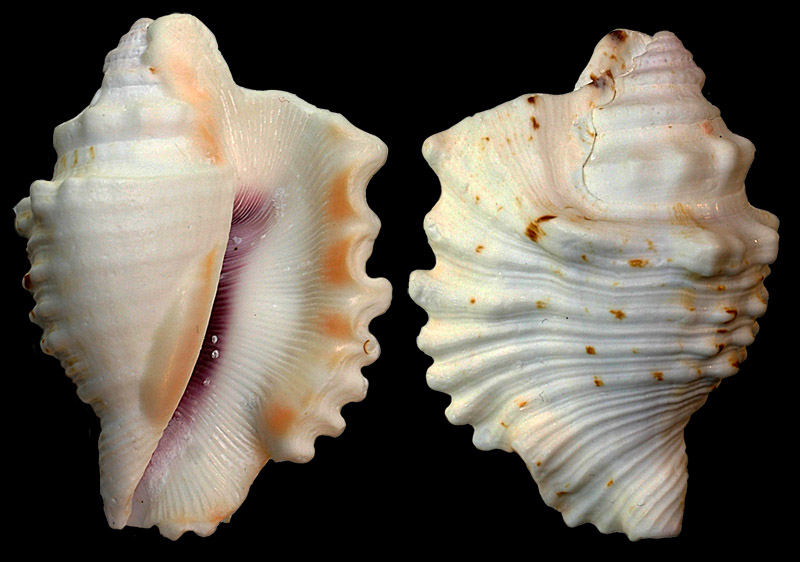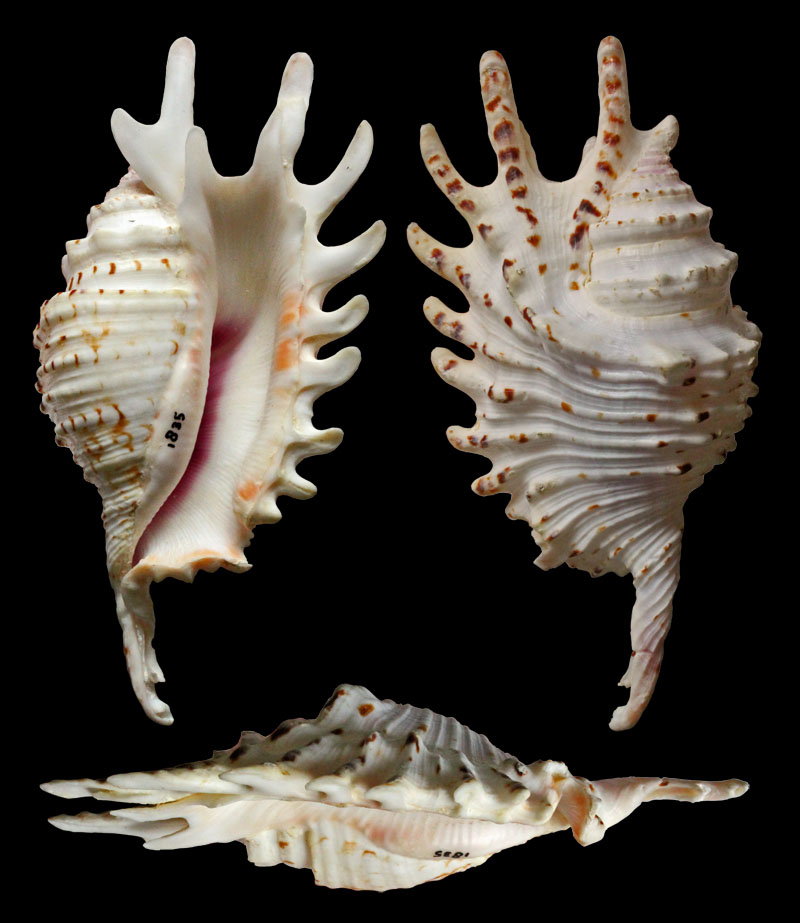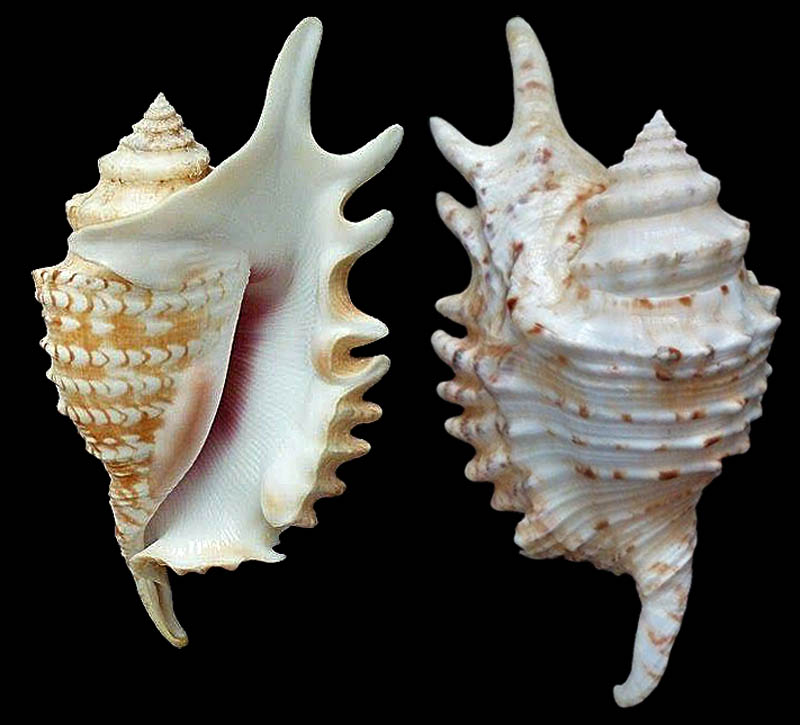|
edit SideBar
|
Species / Ophioglossolambis Violacea
Stromboidea
Original Description of Pterocera violacea by Swainson, 1821:
- "P. Testae labio exteriore processibus 10 brevibus, compressis, (2 superioribus divaricatis) armato; canali brevi; apertura labiisque albis, costatis, intus purpureis."
- "Outer lip with 10 short compressed processes; the two upper divaricated; channel short; aperture and lips white, ribbed, and within purple."
Locus typicus: Saint Brandon Archipelago, northeast of Mauritius Island, Indian Ocean
History and Synonymy
Ophioglossolambis violacea (Swainson, 1821: 12th page) (Pterocera)
- Syn.: Strombus millepeda L. var. C. Dillwyn, 1817: 660
- Syn.: Pteroceras multiples “Chemn.” Sowerby2nd, 1842: 43, pl. 11 fig. 8
- Syn.: Pterocera purpurascens “Swainson” Sowerby2nd, 1842: 43 [in synonymy]
- Syn.: Pterocera purpurea Swainson. Dubois, 1825: 248 [nomen nudum]
- Syn.: Strombus purpureus Mawe, 1823: 127 [nomen nudum]
1787
in Chemnitz, 1787, pl. 157, fig. 1494, 1495
1827
Pterocera multipes Schmidt, 1827 [manuscript name, not available], exColl. Milbert, Coll. Museum der Natur Gotha MNG 4934 [subsequently added no. 11054?]
1836
Pterocera multipes in Cuvier, 1836(?), pl. 61, fig. 3, 3a
- Fig. 3 Ptérocère a pieds nombreux. Pterocera multipes. Desh. Coquille réduite d'un tiers, vue en dessus.
- Fig. 3 a. La même, vue du côté de l'ouverture.
1842
Pteroceras multipes in Sowerby, 1842, pl. 11, fig. 8
1843
Pterocera millepeda var in Kiener, 1843, Vol. 4, Pterocera pl. X, fig. 1
1851
Pterocera multipes in Reeve, 1851, Pterocera, pl. 4, fig. 5
1972
Mienis, 1972, p. 82:
- "In his preliminary account of the genus Lambis in Indonesia, Butot (1955: 79, pi. 2, fig. 6) mentions Lambis (Millepes) violacea (Swainson, 1821) for the first and only time from an Indonesian locality: Ambat, on the east coast of Madura. Quite understandably Abbott (1961: 167) was rather puzzled by this record, as authentic material of this species is only known from the islands in the western part of the Indian Ocean. Yet he mentions Butot's locality in his list of records, but omits it, however, from the map, which shows the distribution of Lambis violacea (loc. cit: p. 168 and pl. 130). The freshwater gastropod Clithon (Clithon) coronata Leach, 1815, better known by its junior synonym Clithon longispina (Recluz, 1841), is a fairly common species of Mauritius, Reunion, Rodriguez and Madagascar, all islands in the same part of the Indian Ocean. Van Benthem Jutting (1956: 283, fig. 12) mentions, however, Clithon coronata in her critical revision of the Javanese freshwater gastropods from a locality in Indonesia: West Java, Muara Tjibuni, Sukabumi. This record is reason for Starmühlner (1969: 56) to consider C. coronata an Indomalaysian stray into the freshwater fauna of Madagascar. During our current revision of the family Neritidae in which we examined more than 120,000 specimens, of which about a quarter had Indomalaysian localities, we never found a second specimen of C. coronata from a locality in Indonesia. The similarity in both cases is therefore striking. The link between both cases is however still much closer. Butot's record of Lambis violacea from Madura and van Benthem Jutting's record of Clithon coronata from Java are both based on material in the collection Ouwens, stored in the Zoological Museum of Bogor, Indonesia. According to van Benthem Jutting (1956: 283) it is a well-known fact that the late Major P. A. Ouwens (1850-1922) was somewhat careless as to localities and labels. The possibility that both records are based on wrongly labelled material is thus very great. We propose, therefore, to leave both records out of any further account until they have been confirmed by more recently collected material. On this basis Lambis violacea and Clithon coronata have to be considered as species with a rather restricted range in the western part of the Indian Ocean, with the possible center of their distribution being Mauritius and the Cargados Carojos Shoals."
Specimens from private collections
Ophioglossolambis violacea (Swainson, 1821)
- Saint Brandon Archipelago, northeast of Mauritius Island, Indian Ocean; dive; 94,1 mm; Coll. Ulrich Wieneke no. 2388
- Saint Brandon Archipelago, northeast of Mauritius Island, Indian Ocean; 1985; 116,1 mm; Coll. Ulrich Wieneke no. 2389
Ophioglossolambis violacea (Swainson, 1821); Saint Brandon Archipelago, northeast of Mauritius Island, Indian Ocean; 1.c: 97 mm, 2.c: 111 mm, 3.c: 134 mm; Coll. Christian Börnke
Ophioglossolambis violacea (Swainson, 1821); Mauritius Island, Indian Ocean; 121mm; Coll. Chong Chen
*Comment Chong Chen:
- "The "Violet Spider Conch" is one of the most famous classic rarities of the conchology world, and perhaps the most beautiful of the spider conchs. Renowned for the deep violet hue inside the aperture, which distinguishes it from all other spider conchs. It is generally considered the most desirable strombid of the Indian Ocean, and was one of the fifty species chosen by S. Peter Dance in 'Rare Shells' (1969). Vast majority of specimens have been collected from Mauritius (especially Saint Brandon), and it appears to be endemic to the Mascarene Basin. Although it is probably not really a rare species in its locality, it is a rare species on the market even today due to limited access to its constrained habitat and the fact that shell collection is restricted by law in Mauritius. Development of digitation and length of siphonal canal highly variable. Immature specimens have unfilled digitation, lacks yellow spots on the outer lip, and has much weaker lirae in the aperture. Average shell length around 110-120mm but giant specimens may approach or even exceed 140mm."
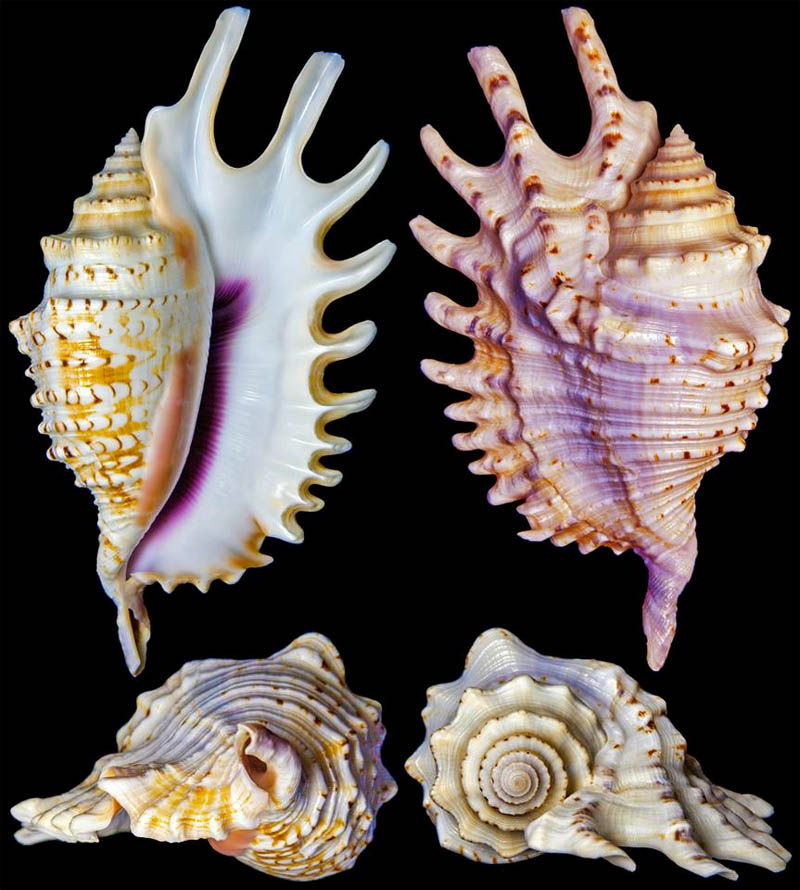 Ophioglossolambis violacea (Swainson, 1821); subadult; Saint Brandon Archipelago, northeast of Mauritius Island, Indian Ocean; 118,2 mm; Coll. Chong Chen
Ophioglossolambis violacea (Swainson, 1821); Saint Brandon Archipelago, northeast of Mauritius Island, Indian Ocean; Coll. Iain Rasmussen
Ophioglossolambis violacea (Swainson, 1821); Saint Brandon Archipelago, northeast of Mauritius Island, Indian Ocean; Coll. Aart Dekkers no. 1521
Ophioglossolambis violacea (Swainson, 1821); dwarf, slightly broken; Saint Brandon Archipelago, northeast of Mauritius Island, Indian Ocean; 56,5 mm; Coll. Ulrich Wieneke
Lambis violacea (Swainson, 1821); freak; Saint Brandon Archipelago, northeast of Mauritius Island, Indian Ocean; Coll. Gijs Kronenberg no. 1835
Lambis violacea (Swainson, 1821); freak; Saint Brandon Archipelago, northeast of Mauritius Island, Indian Ocean; Coll. Iain Rasmussen
References
- Abbott, 1961
- Benthem Jutting, W.S.S. van, 1956. Systematic studies on the non-marine Mollusca of the Indo-Australian Archipelago, V. Critical revision of the Javanese Freshwater Gastropods. Treubia 23(2): 259-477.
- Butot, L. J. M., 1955. Duivelsklauwen, boksbeugels, schorpioenen of enterhaken. Penggemar Alam 35:71-84, 3 pls.
- Georges Cuvier, 1836-1849. Le règne animal distribué d'après son organisation, pour servir de base à l'histoire naturelle des animaux et d'introduction à l'anatomie comparée; Edition accompagnée de planches gravées; Fortin, Masson et cie., Paris, 100 pls.Fulltext
- Drivas & Jay, 1988
- H.J., 1970
- Kronenberg, G.C. & Wieneke, U. 2020. Röding’s Stromboidea (Caenogastropoda): the remains of the Bolten collection in the Museum der Natur Gotha (Germany), a critical review of Röding’s taxa, and notes on the Schmidt catalogue. Basteria 84 (1-3): 85-126.
- Mienis, 1972
- Starmühlner, F., 1969. Die Gastropoden der Madagassischen Binnengewasser. Malacologia 8(1-2):1-434.
|

